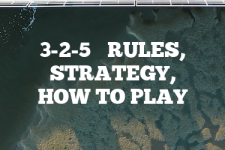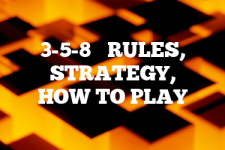Schieber: Learn Strategy, Rules & Instructions
Introduction
Schieber is a popular variant of the Swiss card game Jass (often considered the national card game of Switzerland). Played with a deck of 36 cards, Schieber is a game of strategy and skill that can be enjoyed by 2 to 4 players. I find it plays best with four players.

The game of Jass, from which Schieber is derived, has a history that dates back to the early 19th century. It first appeared in the region of the Netherlands and Germany before making its way to Switzerland. The origin of the name “Jass” is not entirely clear, but a common theory is that it comes from the Dutch word “Jas,” meaning “Jack,” referring to the playing card.
Schieber Jass, specifically, emerged in the late 19th century and is named after the German word “schieben,” which means “to push.” This refers to a unique feature of the game, in which players can choose to “push” the choice of trump suit to their partner if they feel they have a weak hand.
Schieber is typically played with four players in teams of two and uses a deck of 36 cards. The game is complex and involves a mixture of strategy, risk-assessment, and cooperation between team members (and a fair bit of potential drama, in my experience at least!). Points are scored based on the cards played, with the team reaching a predetermined score first winning the game.
Over the years, Schieber has evolved and various regional variations have developed. However, the core rules and gameplay have remained largely the same. The game is ingrained in Swiss culture, often played in pubs, clubs, and at home among friends and family. It is also played in competitions, both at a local and national level.
In recent times, like many traditional card games, Schieber has also made the transition to digital platforms, with online and app-based versions available (this app has 200,000 downloads and is the one I generally recommend). This has allowed the game to reach a wider audience and has helped maintain its popularity in the 21st century.
Quick Tip for Schieber
Remember, communication with your partner is key in Schieber. Use your cards wisely to signal your intentions and strategies.
Rules for playing Schieber
- The game is played with a deck of 36 cards, from six to Ace in each suit.
- Each player is dealt 9 cards in batches of 3.
- The player to the dealer’s right chooses the trump suit or passes the choice to his partner.
- The aim is to score points by taking tricks. The team that reaches 2500 points first wins the game.
The Deal for Schieber
In Schieber, the dealer shuffles the deck and deals 9 cards to each player in batches of 3. The player to the dealer’s right is given the privilege of choosing the trump suit or passing the choice to his partner.
How to Play Schieber
- Setup: Players sit opposite their partners. The dealer shuffles and deals the cards.
- Gameplay: The player to the dealer’s right leads the first trick. Players must follow suit if possible. The highest card of the led suit or the highest trump wins the trick.
- End of the Game: The game ends when a team reaches 2500 points.
- Scoring: Points are scored based on the cards won in tricks. The team with the highest total wins.
How to Win at Schieber
Winning at Schieber requires a good understanding of the game’s rules and a solid strategy. It’s important to communicate with your partner and make the most of your trump cards. Also, remember to keep track of the cards that have been played and adjust your strategy accordingly.
Winning at Schieber, a popular Swiss variation of the card game Jass, requires a combination of skill, strategy, and a bit of luck. Here are some tips on how to increase your chances of winning:
1. Understand the rules: The first step to winning any game is to understand the rules thoroughly. Schieber is a point-based game, and the team that reaches the predetermined point total first wins. The game is played with a 36-card deck and involves bidding and trick-taking.
2. Know the Cards: In Schieber, the card ranking changes based on the trump suit. It’s crucial to remember the ranking of cards for each suit.
3. Bid smartly: The bidding process determines the trump suit for the round, and the team who bids the highest leads the round. Make sure to bid wisely, considering the strength of your hand and your partner’s potential hand.
4. Communication with your partner: Since Schieber is a partnership game, effective communication with your partner is crucial. While direct communication about the cards is not allowed, you can give your partner hints about your hand through your gameplay.
5. Play strategically: Always consider the number of points you can gain versus the points your opponents can gain. Sometimes it’s smarter to let your opponents win a trick to prevent them from scoring higher in a later trick.
6. Remember the Cards: Try to remember what cards have been played. This will help you predict what cards your opponents might have, allowing you to make better strategic decisions.
7. Practice: Like any other game, practice makes perfect. The more you play, the better you’ll understand the strategies and nuances of the game.
Remember, while these strategies can help improve your gameplay, Schieber, like all card games, still involves an element of luck. However, consistently applying these strategies can definitely increase your chances of winning.
Strategy for playing Schieber
One of the best strategies in Schieber is to play your high cards early, especially if they are in the trump suit. This allows you to take control of the game and put pressure on your opponents. Also, try to keep track of the cards that have been played and use this information to your advantage.
Variations
Schieber, a popular Swiss card game, boasts several intriguing variations that add depth and complexity to the traditional rules. These variations include Coiffeur, Differenzler, and Slalom, each of which introduces unique rules and novel strategies. Coiffeur changes up the game by forcing players to announce their expected points before the round begins. Differenzler, on the other hand, aims to minimize the difference between predicted and actual points. Slalom introduces a rule where players have to alternate between taking the maximum and minimum number of tricks. These variations not only enhance the excitement of the game, but also challenge players to adapt their tactics and think on their feet.
Scenarios
There are many scenarios that can arise in a game of Schieber. For example, you might find yourself with a hand full of trump cards, or you might be dealt a hand with no trumps at all. In such situations, it’s important to adapt your strategy and make the most of the cards you have.
In a game of Schieber, a popular Swiss version of the card game Jass, the variety of scenarios that can emerge are vast and require a flexible strategy. The cards you are dealt at the beginning of the round can significantly influence the course of the game. Here are a few potential scenarios and strategies to consider:
1. A Hand Full of Trump Cards: A hand full of trump cards can be a major advantage. Trump cards are higher in rank and can take any card of another suit. With a hand full of trumps, you can dominate the game, but ensure to use them wisely. Be strategic about when you play these cards to maximize their potential and avoid wasting them on low-value rounds.
2. A Hand with No Trumps: On the other hand, you might find yourself with a hand devoid of any trump cards. This situation requires a more defensive strategy. One approach is to get rid of your high-value cards early in the game when it’s less likely that they’ll be trumped. Another strategy is to collaborate with your partner (in a four-player game) and save your high-value cards for when they can play a trump.
3. A Balanced Hand: A balanced hand, with an equal distribution of trump and non-trump cards, requires a flexible approach. You might decide to play aggressively at the start, using your high-value and trump cards to win rounds early. Alternatively, you might adopt a more conservative approach, saving your trump cards for later in the game.
4. A Hand with Many Cards of One Suit: If you are dealt a hand with many cards of one suit, it can be advantageous to try and make that suit the trump. This way, you can control when that suit is played and use your abundance of a single suit to your advantage.
5. A Hand with High-Value Non-Trumps: If you have a hand with several high-value non-trump cards, it’s important to play these cards at the right time. They may not be as powerful as trump cards, but played correctly, they can still win you rounds.
Ultimately, the key to success in Schieber lies in adaptability and strategy. Whether you’re dealt a hand full of trumps, no trumps, or anything in between, it’s essential to adjust your approach based on the cards you have, the progress of the game, and the actions of your opponents.
Frequently Asked Questions about playing Schieber
- What is the trump suit in Schieber? The trump suit is chosen by the player to the dealer’s right or his partner.
- How many cards are dealt in Schieber? Each player is dealt 9 cards in batches of 3.
- How do you score points in Schieber? Points are scored based on the cards won in tricks.
- What is the objective of Schieber? The aim is to score points by taking tricks. The team that reaches 2500 points first wins the game.
- How many players can play Schieber? Schieber can be played by 2 to 4 players.
External Links
Read a local Swiss newspaper’s perspective on Jass/Schieber and its place in Swiss culture

Eve Brownlee was a gamer before gaming communities on the internet were a thing. Eve grew up playing traditional, standard deck card games like Rummy and Bezique, taking an interest in the classics Backgammon and Chess. Parlor card games like Bridge continue to keep Eve active in the community. After a long career, primarily in horticulture for USDA in Maryland, Eve now travels and writes on The Pineapple (pineapples.info) and contributes to Quora/Pinterest topics. Contact Eve via email.



